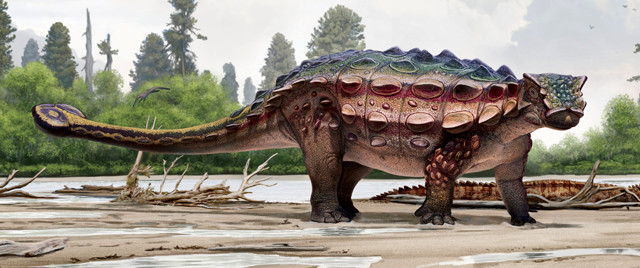
by Mary Caperton Morton Tuesday, October 16, 2018

An artist's vision of the newly discovered Akainacephalus johnsoni. The unusually spiky armored head points to an Asian origin for this new genus and species. Credit: ©Andrey Atuchin/DMNS.
A new genus and species of ankylosaurid discovered in Grand Staircase-Escalante National Monument in southern Utah reveal new information about the spread of armored dinosaurs into North America. Most North American ankylosaurids are known for their smooth skulls, but the new specimen more closely resembles spiky-skulled Asian ankylosaurids.
The new specimen, dubbed Akainacephalus johnsoni, was named for the Greek words “akaina,” meaning “thorn” or “spike,” and “cephalus,” meaning “head,” as well as for dedicated museum volunteer Randy Johnson, who helped prepare the dinosaur for display at the Natural History Museum of Utah in Salt Lake City. The formidable arrangement of cone- and pyramid-shaped bony armor on Akainacephalus’ snout and head point to a close relationship with the similarly prickly New Mexican ankylosaurid Nodocephalosaurus kirtlandensis.
In a new study published in PeerJ, researchers assert that Akainacephalus and Nodocephalosaurus are more closely related to Asian ankylosaurid genera, such as Saichania and Tarchia, than to other Late Cretaceous North American ankylosaurids, including Ankylosaurus and Euoplocephalus, which sport flattened skull armor. The new specimen of Akainacephalus, which dates to 76 million years ago, is also one of the most complete North American ankylosaurids found to date, including an intact skull, most of the vertebral column, the tail club, parts of the fore and hind limbs, and some body armor, including distinctively spiked armor plates.
Study authors Jelle Wiersma, now at James Cook University in Queensland, Australia, and Randall Irmis, at the Natural History Museum of Utah in Salt Lake City, suggest that the spiky skulled ankylosaurids may have crossed over the Beringian land bridge between Asia and North America, resulting in two distinct populations. Ankylosaurids are thought to have originated in Asia between 125 million and 100 million years ago, and appear in the North American fossil record about 77 million years ago, 11 million years before the end of the Cretaceous.
© 2008-2021. All rights reserved. Any copying, redistribution or retransmission of any of the contents of this service without the expressed written permission of the American Geosciences Institute is expressly prohibited. Click here for all copyright requests.